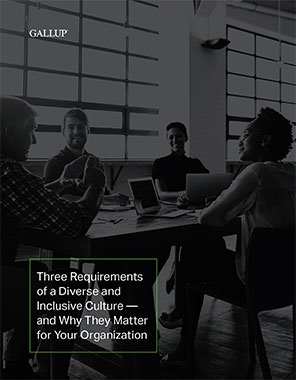Story Highlights
- To excel, employees must feel valued, respected and accepted
- A strengths-based work culture celebrates each employee's uniqueness
- Including all backgrounds and viewpoints is a competitive advantage
Many modern workplaces are striving to become more diverse and inclusive.
But too often, organizations struggle to determine how, exactly, to put diversity and inclusion (D&I) into practice.
Wide demographics alone won't make a difference to an organization's bottom line unless the people within those demographics feel authentically welcomed.
Part of the problem is that many D&I solutions keep companies on the defensive. That is, they primarily address concerns such as promoting compliance and diversity in race, age and ethnicity.
That's not enough. Wide demographics alone won't make a difference to an organization's bottom line unless the people within those demographics feel authentically welcomed.
In other words, leaders need both a diverse workforce and an inclusive workplace culture to realize the business benefits of D&I, such as reduced turnover and higher performance.
Why? To excel, employees must feel valued, respected, accepted and encouraged to fully participate in the organization. They need to feel recognized for their unique backgrounds, experiences, personalities and the things they do exceptionally well -- their strengths.
Here's what an inclusive work culture looks like:
1. Everyone treats everyone else with respect.
Building an inclusive culture is the shared responsibility of employees, managers and organizational leaders. It takes intention at every level to sustain an inclusive workplace.
2. Employees are valued for their strengths.
When employees understand their strengths, they can tap into what motivates them and what they naturally do best. They can also identify any blind spots related to observing, evaluating or demonstrating respect for others.
3. Leaders do what's right.
Leaders need to be fair and unbiased in hiring, assigning work, evaluating compensations and making promotions -- and hold managers accountable for doing the same.
It's also up to leaders to architect an organizational culture in which employees feel they can safely express themselves and raise concerns with transparency and confidence.
These three characteristics sound great on paper. The challenge for leaders is transforming aspiration into reality.
Unfortunately, many organizations have room to improve. Just four in 10 U.S. workers say they have the opportunity to do what they do best each day.
Worse, only three in 10 U.S. employees strongly agree that their opinions seem to count at work.
So, what can leaders do differently?
Strengths-based development has long been considered an effective approach for developing employees, accelerating performance and improving business outcomes, but it is not often associated with creating inclusive cultures.
It's time for that to change.
A strengths-based workplace culture encourages, embraces and celebrates each employee's unique contributions. Consequently, employees feel valued for who they are -- and they have everything they need to thrive.
Further, teams can more effectively collaborate and innovate in a work environment that emphasizes what each team member brings to the table.
In fact, helping each contributor play to their strengths is the most time-effective way to improve performance and engagement at work -- period.
A strengths-based work culture encourages, embraces and celebrates each employee's unique contributions.
To get there, leaders need to turn their attention to the manager.
It's up to managers to appreciate each employee's unique characteristics -- in everything from performance management to task assignment.
Exceptional managers serve as coaches who continually cultivate employees' strengths and help each individual hone their natural abilities.
But managers can't excel at strengths-based management without the right training and ongoing support from a C-suite who prioritizes a strengths-oriented workplace culture.
It's up to managers to appreciate each employee's unique characteristics -- in everything from performance management to task assignment.
Leaders should equip managers with right resources, education and tools. Just as important, leaders must own their roles as managers of managers -- that is, they need to recognize what each manager does best and further develop those strengths.
Businesses can capture a powerful competitive advantage when they invite and include all types of backgrounds, experiences and viewpoints.
In fact, Gallup analytics show that organizations with strengths-based work cultures can achieve world-class performance. This type of organizational culture can also help businesses remain agile in the future of work.
Perhaps best of all, employees who belong to a strengths-based, inclusive culture can foster deeper relationships with customers. When each employee owns their role in delivering on the brand promise, they can better contribute to exceptional customer experiences that keep customers happy and wanting more.
Gallup can help your organization develop a truly inclusive workplace culture:
- Sign up for an exclusive content preview from our new book, It's the Manager.
- Download our free perspective paper and learn the three requirements for a diverse and inclusive workplace.
- Help everyone at your organization discover and maximize their unique strengths.
- Partner with us to create a more diverse and inclusive culture at your organization.



